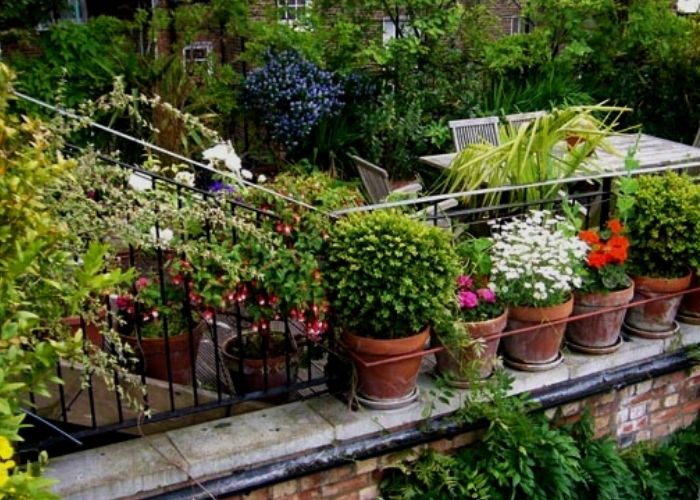Today we will talk about Rooftop Garden Benefits and Vegetation: If your roof has unused or underused spaces, installing a rooftop garden is the right thing for you to do. This is not the only reason why you should consider installing a roof garden though.
I’ve seen people living in cities struggle for breathing in nature.
Using the empty space on your rooftop is the best way to take the advantage of the area. You can choose the plants according to your wish, spend your leisure time with full relaxation here, and enhance the value of your property.
Still, it’s not the whole picture, trust me. There are other compelling reasons for installing a garden on your roof. Now, let’s go through this piece about ‘Rooftop garden benefits and vegetation’ so you can get to know everything about the topic.
What Is Rooftop Gardening? What Are The Different Types?
When you grow a garden on the roof of a building, it’s called a roof garden. Most people do it for decorative benefits a roof garden can be more than that. For example, plants of a roof garden provide food, control the temperature, provide hydrological benefits, and so on.
There are three basic types of roof gardens according to roof vegetation and maintenance.
1. Extensive Roof Gardens
This type of roof garden has a lightweight, thin growing medium and it’s a low-maintenance green roof garden. In simpler words, these gardens require the least layers of soil substrate.
Besides roofs, you can grow such a garden in garages, storehouses, or additional buildings of your house. However, here’s you have limited options for the vegetation types, so, don’t expect to get much aesthetical value from it.
The most suitable vegetation for these gardens are mosses, sedums, small plants, herbs, succulents, flowers, and desert grasses.
It’s easier and less expensive to install an extensive garden roof because its growing medium is 3-6 inches deep. Also, irrigation isn’t a must to make this roof garden survive. Especially, for low-sloped and flat roofs, this gardening system is the right option for stormwater management.
2. Intensive Roof Gardens
Intensive roof gardens require stable and large constructions so it might be a bit challenging to find a suitable building for such gardens. The design of this garden is characterized by deep soils. Usually, the soils have a growing medium with a depth of 6-inches or more.
You can choose a variety of vegetation when it comes to intensive vegetation. I mean, you can plant from small to large plants, groundcovers, shrubs, and whatnot! But it not only requires basic maintenance needs but also special attention to irrigation. It will help to produce different kind of best vegetables round the year especially who people are having with weight loss issues.
3. Semi-Intensive Roof Gardens
As its name sounds, a semi-intensive roof garden is a mix of both extensive and intensive ones. The growing medium for these gardens is around 6-12 inches which helps host a richer ecology.
You can consider planting small herbs, grasses, small plants, and groundcovers in this type of roof garden. People also choose some species of wildflowers that are low-maintenance. This garden requires moderate maintenance plus occasional irrigation. However, additional watering is required for prolonged dry periods.
About retaining stormwater, this roof garden is even more capable of doing the job. The design or structure of such a garden makes it perfect as daycare play spaces and long-term care facilities.
How Are Rooftop Gardens Constructed?
While cross-section a roof garden, the first thing you’ll notice is an insulation layer at the base. After that, there’s a waterproof membrane that prevents leakage from the building. Also, you’ll see a root barrier that prevents the roots from penetrating via the waterproof membrane.
Some plant roots release acids. So, there’s a waterproof membrane used that can withstand the effects of the acids. Next, there’s a drainage layer to maintain the water level. This layer is made of lightweight gravel, clay, or plastic. It aerates the growing media as well.
Since the roof system covers the shole roof here, the drainage points should be accessible from the top. In some constructions, the drainage layer has the ability to store water so the plants can use it later.
A filter mat or geotextile is used on the top of the drainage layer. What it does is to let the water soak through plus prevent soil erosion.
And, lastly, growing media, plants, and a wind blanket are used to compose the top layers. The growing media has to be lightweight and should help to supply nutrients to plants. Hence, the wind media holds the growing media so it can be stable in the place prior to the plants’ roots being formed.

Rooftop Garden Benefits and Vegetation
If you’ve ever wondered thinking about ‘why are rooftop gardens sustainable?’, this section is going to give you the answer.
1. Economic Benefits
One of the major economic benefits of rooftop gardens is that it increases property values. So, you don’t have to worry about the investment in the construction because it’s worth the structure for a modest expenditure.
If you like numeric results, independent researchers stated that a roof garden adds up to 25% value to the property.
2. Environmental Benefits
Since it’s about plants, you may guess that there are thousands of rooftop garden environmental benefits.
Roof gardens insulate against heat and cold. Buildings that have a roof garden lose 30% less heat in cold seasons. It improves the thermal resistance of the roof around the year. Speaking of thermal resistance, roof gardens save fuel and reduce cooling costs on summer days.
Another compelling reason why roof gardens are the champs is that they retain and manage stormwater. Yes, roofs with gardens absorb about 75% of rainfall which decreases the runoff drastically as well as lowers the risk of urban flooding.
Therefore, you can say that the elevated roof gardens modify the entire urban micro-climate.
You’ll get other examples like improved air quality, habitat for birds, less room for weeds, and so on.
3. Nutritional Benefits
So, you live in a city where you face a lack of fresh fruits and vegetables because there’s no access to farmer’s markets near you.
But think about growing a roof garden where you can grow any kind of fresh and exotic fruits and vegetables. All you need to do is to make sure that your desired plants can be grown in the climate where you live.
If you can ensure the nutritional availability from your roof garden, it will save your money as well.
4. Aesthetic Gratification
This may seem less important to you but a rooftop garden provides a great leisure & relaxing opportunity. The overall environment of your neighborhood will be improved with beneficial wildfires like birds, butterflies, and bees. Eventually, it’ll help balance biodiversity.
5. Other Benefits
Roof gardens are pretty easy to re-arrange. Think about an ordinary garden, don’t you have to plan for a long-time plantation? I mean, in most cases, shrubs, fruits, flowers, or whatever you plant they remain there for quite a long time (as the plants take root there).
However, this could be a good option if you’re looking for something stable. But if you re-arrange things often, re-arranging a rooftop garden is easier.
Also, it’s always easier to ensure enough sunlight for the plants if you’re planting them on a roof garden. There are plants that require a lot of sunlight to grow. But still, you can’t let them be sunburnt because there are recommended levels.
So, think about a roof garden that allows both sunlight and cloud to appear and make your plants survive.
It’s possible to use rainwater effectively if you deal with a roof garden. Since rainwater is free energy, let a rooftop garden make the most use of it. Such a garden can retain around 80% of rainfall. And, guess what happens after the water is used?
It gets back to the atmosphere through evaporation and transpiration. Overall urban agriculture can go far with the innovation of roof gardening.
Additional Tips for Installing A Rooftop Garden
Hopefully, now you know why rooftop vegetation should be your concern. But before you start working on your own roof garden, go through the tips below so you don’t make major mistakes afterward.
1. Temperature Variants
Extreme variations in temperature affect your roof. In cool weather, the roof membrane shrinks whereas it expands in hot weather. Can you guess what happens for the constant expansion and construction? It eventually shortens the lifespan of your roof.
But the good news is, rooftop gardens regulate temperatures, work as a natural barrier, and protect the roof of your building from damages.
While installing a roof garden, make sure you install a waterproofing membrane to make your roof waterproof. It prevents water from infiltrating the building and controls the natural expansion of the roof. Therefore, waterproofing will extend the roof and the garden’s lifespan.
2. Plants
Which plants should be in your garden is up to your preference or aesthetic needs. However, it highly depends on the climate of your living place as well as the exposure to harsh elements.
Since hardy plants are durable and attractive at the same time, you can consider planting them. Or, if you like simplicity, go and create a vegetable garden or plant citrus plants or other potted dwarf trees.
And, if you’re a person who manages a busy schedule, go for low-maintenance plants that require little water or pruning to survive. If you take the garden super seriously and want to get the whole job done professionally, hire a landscaper to get help to select the right plants for your garden.
3. Costs
The cost of rooftop gardens depends on the design site, size, and the construction materials you use for the garden. Generally, the initial cost is quite high but the long-term savings don’t sound a big deal.
You can stop worrying about heating and cooling systems after installing a rooftop garden and if it’s a vegetable garden, your grocery shopping bill will be reduced. Now, let’s talk about typical preparation and maintenance costs like structural supports, drainage, waterproofing, etc.
For the above-mentioned factors, a small roof garden costs somewhere between $150 and $400 per square meter. It’s a calculation without other costs like design fees, permits, etc.
Frequently Asked Questions
Question: How effective are rooftop gardens?
Answer: They are extremely effective insulation systems and they eventually lower the expenditure of cooling a building.
Question: Can we grow grass on the roof?
Answer: Yes. But your roof’s base needs some prep work so make sure you do it right beforehand.
Question: How much water do green roofs absorb?
Answer: A typical green roof can absorb up to 75% of the annual precipitation of the US.
Question: What should I consider before growing vegetables on a rooftop?
Answer: Make sure you select large and deep pots to grow vegetables. It’s because thin or poor-quality plastic pots can heat up fast and drain poorly. And, use good-quality potting mix instead of using normal garden soil to get healthy growth and productivity of plants.




